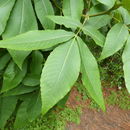More info for the term:
swampShagbark hickory is most commonly associated with upland slopes in the
North, and with river bottoms and coves in the South [
23]. It also
grows on the lower slopes of wooded bluffs, in ravines, valleys, and at
the edges of swamps [
21,
29]. Shagbark hickory generally occurs as
scattered individuals or in small groups but rarely forms pure stands
[
2,
51].
Plant associates: Shagbark hickory occurs as a principal dominant in
drier parts of the upper Midwest with oaks (Quercus spp.) and other
hickories. [
59]. It also grows as aminor component in bur oak (Q.
macrocarpa), chestnut osk (Q. prinus), white oak (Q. alba)-black
oak-northern red oak, pine (Pinus spp.)-oak-sweetgum (Liquidambar
styraciflua),loblolly pine (Pinus taeda)-hardwood, and swamp chestnut
oak (Quercus prinoides)-cherrybark oak (Q. falcata var. pagodaefolia)
[
23]. Many oaks, including white oak, northern red oak, black oak,
northern pin oak (Quercus ellipsoidalis), southern red oak (Q. falcata),
chinkapin oak (Q. muehlenbergii), bur oak, and other hickories are
generally prominent overstory associates [
1,
23,
59]. Red maple (Acer
rubrum), sugar maple (A. saccharum), hophornbeam (Ostrya virginiana),
shortleaf pine (Pinus echinata), American basswood (Tilia americana),
redbud (Cercis canadensis), and sourgum (Nyssa sylvatica) also commonly
occur with shagbark hickory [
2,
48].
Understory associates are numerous and varied throughout the species'
range. Raspberries and blackberries (Rubus spp.), blueberries and
huckleberries (Vaccinium spp.), rhododendron (Rhododendron spp.),
serviceberry (Amelanchier spp.), gooseberries (Ribes spp.), hawthorn
(Crataegus spp.), hazel (Corylus cornuta), muscadine grape (Vitis
rotundifolia), common greenbrier (Smilax rotundifolia), western
snowberry (Symphoricarpos occidentalis), common witch-hazel (Hamamelis
virginiana), wild ginger (Asarum caudatum), nettle (Urtica spp.), and
Canada beadruby (Maianthemum canadense) are important understory
components in many areas [
2,
3,
9].
Climate: Shagbark hickory grows across a wide range of climatic
conditions but grows best in a humid climate. It can survive
temperature extremes of -40 degrees F (-40 deg C) and 115 degrees F (46
deg C). Growing season length varies from 140 days in the North to 260
days in the South [
23].
Soils: Shagbark hickory reaches greatest abundance on deep, rich, moist
soils [
29,
42]. It occurs on soils derived from a variety of sedimentary
and metamorphic parent materials and grows across a wide range of soil
fertility conditions [
23]. It appears to be tolerant of soils with high
concentrations of lead and zinc [
6]. In Arkansas, it is common on
clayey soils derived from Mississippian and Pennsylvanian shales [
23].
Elevation: Shagbark hickory generally occurs at high elevations in much
of the North [
42]. It typically occurs below 3,000 feet (910 m) in the
foothills of West Virginia [
15]. In the Blue Ridge Mountains of North
and South Carolina, it occurs up to 3,000 feet (910 m) and in northern
Arkansas at elevtions below 2,000 feet (610 m) [
23].

